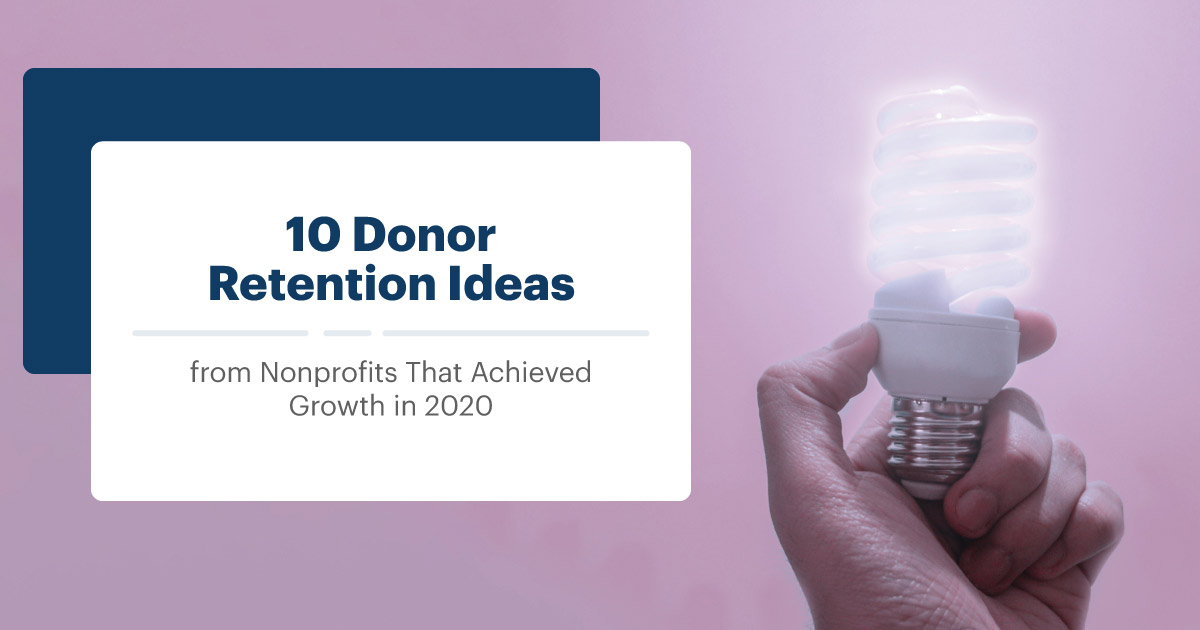Nonprofit Technology & Fundraising Blog
Subscribe to our mailing list
April 28, 2021 |

For as long as donors have been giving, it’s been a best practice for nonprofit professionals to put energy toward retaining them. But after the ways COVID-19 changed the fundraising game, fundraisers are finding themselves having to rethink just how to do it.
So, who better to ask than nonprofits who grew their donor retention amid the pandemic?
The DonorPerfect Team surveyed our top donor-retaining customers to collect donor retention ideas that work, even in a challenging climate.
The 2020 DonorPerfect Fundraising Benchmarks Report suggests that there’s a strong correlation between growth in giving and donor retention. Though the COVID-19 crisis negatively impacted overall revenue, those who maintained strong donor retention fared better than those who did not.
Check out these tried and true donor retention strategies from nonprofits who made it work during 2020.
In the midst of lockdown orders, many nonprofit professionals found success in promoting donor retention by bringing their typical donor engagement communications to life. Here are the strategies that worked for them:
While some fundraisers cut back on communications during the crisis, those who increased donor engagement saw better donor retention rates. Those nonprofits attribute their success to “over communicating.” For one nonprofit in particular, what had long been their quarterly newsletter was transformed into a monthly e-newsletter. Changing up their format and updating supporters on their needs and impact kept their mission top-of-mind for donors.
With digital communication becoming the norm, many nonprofit professionals made time in 2020 for a donor engagement makeover. By devoting resources to reviewing and refreshing your nonprofit’s social media content, your website, and your email campaigns, you may uncover opportunities to better engage them. Try these steps to help identify areas of improvement:
For more ways to revamp your nonprofit marketing content, check out the webinar, Your 2020 Digital Communications Makeover.
Once a donor gives, you’re one foot in the door! You’ve already inspired them to donate before, and chances are, they’re likely to give again if you give them a nudge. Some fundraisers say that they check in with lapsed donors on a yearly basis. This is a chance for you to provide an update on the impact their previous gift has made – and to show them with photos and videos.
When you give your donors a voice in your mission, they feel more like partners in its success. During the pandemic, nonprofit professionals let their donors know they were listening by inviting them to participate in video calls with the board and surveying them about ways they could improve their operations.
Donors deeply appreciate transparency from their nonprofit’s leadership, and they want to know them! Involving your board members in your fundraising efforts can help you to spotlight the people behind your organization and build trust. Some ideas nonprofit professionals shared were to:
If there’s one good there’s one good thing that came out of the pandemic, it’s that folks were reminded to take better care of their relationships. In the same way they picked up the phone to call their loved ones, nonprofit professionals sent kind messages to their donors to let them know they care. In addition to an occasional phone call or handwritten letter, let your donors know that you’re there for their support just as much as they are for you.
Nonprofit professionals who’ve grown their donor retention during the pandemic inspired donors’ confidence in their mission by sharing the direct results of their gifts in a tangible way. This way, donors can see for themselves how their hard-earned dollars are allocated. Some virtual and socially-distanced ideas fundraisers shared were to:
During the pandemic, many nonprofit professionals quickly learned that they can depend on monthly donors to maintain revenue. The industry average for donor retention is ~42%. However, DonorPerfect client data tells us that that average rockets to 90% when measuring only monthly donors. Many nonprofit organizations established monthly giving programs throughout 2020 knowing they’d gain funds they could rely upon for the long haul.
While apart from their donors, nonprofit professionals took to social media to share what their mission means to those they help, the history of their organization, and a more intimate look into their daily lives on the job.
The authentic, friendly nature of this format makes donors feel more like your Facebook friend and part of your wonderful community. Even if you don’t have many followers, social media platforms are an excellent way to store memories that you can easily search for when you’re looking to recycle content for your other communications.
Notifications
Follow us on social!